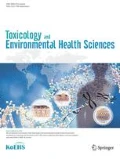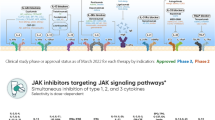Abstract
Toll-like receptors (TLRs) play an important role in the induction of innate immune responses recognizing conserved microbial structural molecules. The microbial pathogens trigger the activation of two downstream signaling pathways of TLRs; myeloid differential factor 88 (MyD88)- and toll interleukin-1 receptor domain containing adapter inducing interferon-β (TRIF)-dependent pathways leading to the activation of nuclear factor-κB (NF-κB) and interferon regulatory factor 3 (IRF3). Saussureae Radix has been used for centuries to treat a variety of diseases. Costunolide, one of the active ingredients in Saussureae Radix, has been used to treat many chronic diseases. However, the mechanism of costunolide’s beneficial effects is largely unknown. Here, we report biochemical evidence that costunolide inhibits NF-κB activation and cyclooxygenase-2 expression induced by the TLR3 agonist polyriboinosinic polyribocytidylic acid (poly[I : C]) or the TLR4 agonist lipopolysaccharide (LPS). These results suggest that costunolide can modulate the immune responses regulated by TLR signaling pathways.
Similar content being viewed by others
References
Medzhitov, R. Toll-like receptors and innate immunity.Nat Rev Immunol 1, 135–145 (2001).
O’Neill, L. A. TLRs: Professor Mechnikov, sit on your hat.Trends Immunol 25, 687–693 (2004).
Vogel, S. N., Fitzgerald, K. A. & Fenton, M. J. TLRs: Differential adapter utilization by toll-like receptors mediates TLR-specific patterns of gene expression.Mol Interv 3, 466–477 (2003).
Takeda, K. & Akira, S. Toll-like receptors in innate immunity.Int Immunol 17, 1–14 (2005).
Lin, R., Heylbroeck, C., Pitha, P. M. & Hiscott, J. Virus-dependent phosphorylation of the IRF-3 transcription factor regulates nuclear translocation, transactivation potential, and proteasome-mediated degradation.Mol Cell Biol bd18, 2986–2996 (1998).
Navarro, L. & David, M. p38-dependent activation of interferon regulatory factor 3 by lipopolysaccharide.J Biol Chem 274, 35535–35538 (1999).
Kawai, T.et al. Lipopolysaccharide stimulates the MyD88-independent pathway and results in activation of IFN-regulatory factor 3 and the expression of a subset of lipopolysaccharide-inducible genes.J Immunol 167, 5887–5894 (2001).
Gao, J. J.et al. Autocrine/paracrine IFN-alphabeta mediates the lipopolysaccharide-induced activation of transcription factor Stat1alpha in mouse macrophages: Pivotal role of Stat1alpha in induction of the inducible nitric oxide synthase gene.J Immunol 161, 4803–4810 (1998).
Pandey, M. M., Rastogi, S. & Rawat, A. K. Saussurea costus: Botanical, chemical and pharmacological review of an ayurvedic medicinal plant.J Ethnopharmacol 110, 379–390 (2007).
Matsuda, H.et al. Effects of sesquiterpenes and amino acid-sesquiterpene conjugates from the roots of Saussurea lappa on inducible nitric oxide synthase and heat shock protein in lipopolysaccharide-activated macrophages.Bioorg Med Chem 11, 709–715 (2003).
Kang, J. S., Yoon, Y. D., Lee, K. H., Park, S. K. & Kim, H. M. Costunolide inhibits interleukin-1beta expression by down-regulation of AP-1 and MAPK activity in LPS-stimulated RAW 264.7 cells.Biochem Biophys Res Commun 313, 171–177 (2004).
Lee, M. G., Lee, K. T., Chi, S. G. & Park, J. H. Costunolide induces apoptosis by ROS-mediated mitochondrial permeability transition and cytochrome C release.Biol Pharm Bull 24, 303–306 (2001).
Chen, H. C., Chou, C. K., Lee, S. D., Wang, J. C. & Yeh, S. F. Active compounds from Saussurea lappa Clarks that suppress hepatitis B virus surface antigen gene expression in human hepatoma cells.Antiviral Res 27, 99–109 (1995).
Ahn, S. I., Lee, J. K. & Youn, H. S. Inhibition of homodimerization of toll-like receptor 4 by 6-shogaol.Mol Cells 27, 211–215 (2009).
Ahn, S. I. & Youn, H. S. Guggulsterone suppresses the activation of NF-κB and expression of COX-2 induced by toll-like receptor 2, 3, and 4 agonists.Food Sci Biotechnol 17, 1294–1298 (2008).
Youn, H. S.et al. Specific inhibition of MyD88-independent signaling pathways of TLR3 and TLR4 by resveratrol: Molecular targets are TBK1 and RIP1 in TRIF complex.J Immunol 175, 3339–3346 (2005).
Youn, H. S., Saitoh, S. I., Miyake, K. & Hwang, D. H. Inhibition of homodimerization of Toll-like receptor 4 by curcumin.Biochem Pharmacol 72, 62–69 (2006).
Simmons, D. L., Levy, D. B., Yannoni, Y. & Erikson, R. L. Identification of a phorbol ester-repressible vsrc-inducible gene.Proc Natl Acad Sci USA 86, 1178–1182 (1989).
Vane, J. R., Bakhle, Y. S. & Botting, R. M. Cyclooxygenases 1 and 2.Annu Rev Pharmacol Toxicol 38, 97–120 (1998).
Murakami, A. & Ohigashi, H. Targeting NOX, INOS and COX-2 in inflammatory cells: Chemoprevention using food phytochemicals.Int J Cancer 121, 2357–2363 (2007).
Kawai, T. & Akira, S. Toll-like receptor and RIG-I-like receptor signaling.Ann N Y Acad Sci 1143, 1–20 (2008).
Kawai, T. & Akira, S. Signaling to NF-kappaB by Toll-like receptors.Trends Mol Med 13, 460–469 (2007).
Fitzgerald, K. A.et al. IKKepsilon and TBK1 are essential components of the IRF3 signaling pathway.Nat Immunol 4, 491–496 (2003).
Meylan, E.et al. RIP1 is an essential mediator of Toll-like receptor 3-induced NF-kappaB activation.Nat Immunol 5, 503–507 (2004).
Author information
Authors and Affiliations
Corresponding author
Rights and permissions
About this article
Cite this article
Park, SJ., Yun, SM., Lee, AN. et al. Costunolide inhibits cyclooxygenase-2 expression induced by toll-like receptor 3 or 4 agonist. Toxicol. Environ. Health. Sci. 1, 122–126 (2009). https://doi.org/10.1007/BF03216473
Accepted:
Issue Date:
DOI: https://doi.org/10.1007/BF03216473




